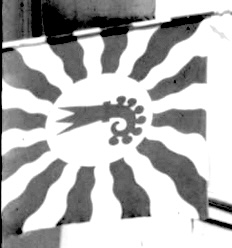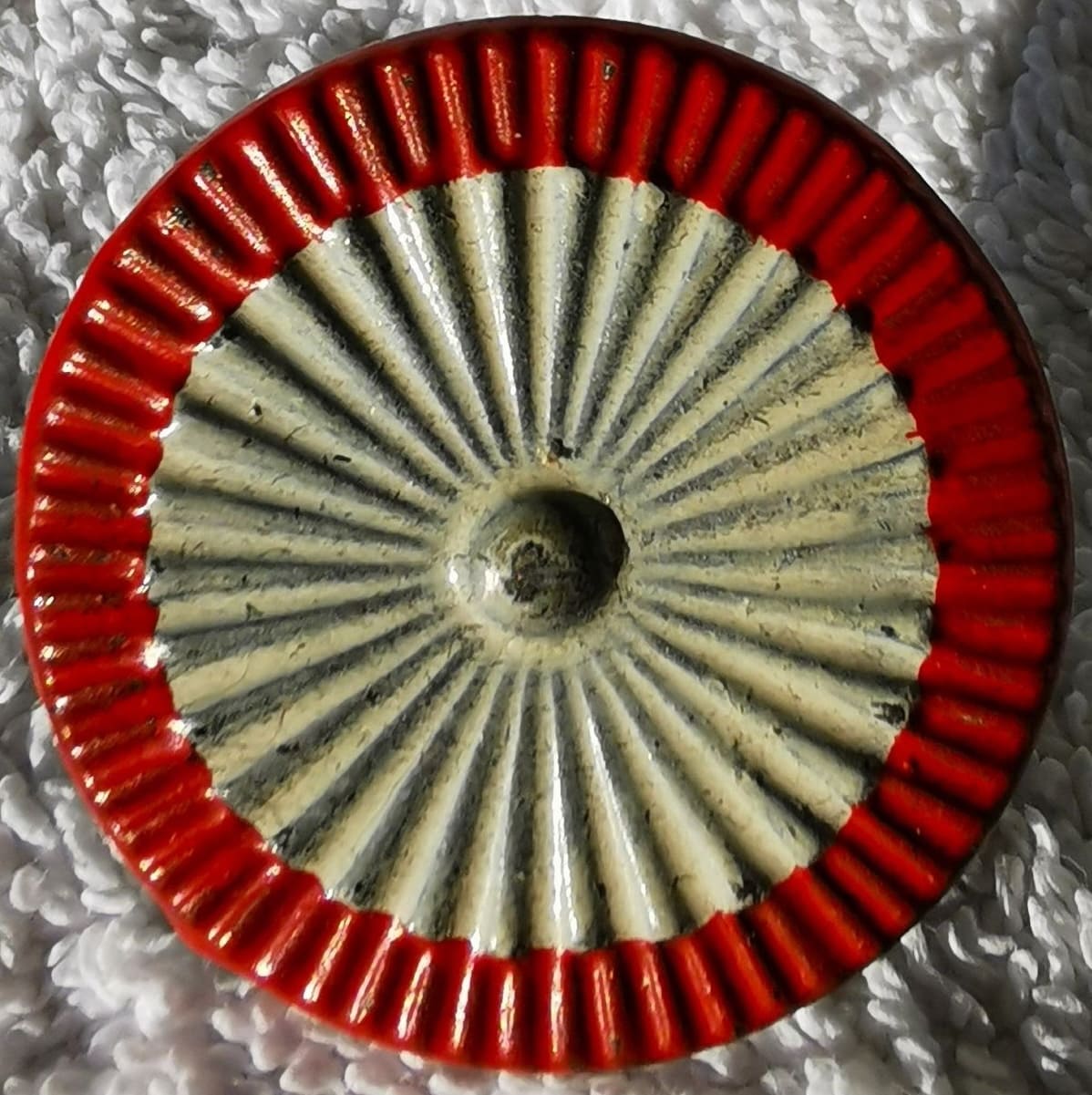![[Flag of Baselland]](../images/c/ch-bl.gif) image by António Martins
image by António Martins
Last modified: 2025-03-15 by martin karner
Keywords: switzerland | basel | baselland | half-canton | german |
Links: FOTW homepage |
search |
disclaimer and copyright |
write us |
mirrors
Blazon by Mühlemann (1991): Arms: In
Silber ein linksgewendeter roter Bischofsstab (Baselstab) mit sieben roten
Krabben (gotischen Verzierungen) am Knauf.
Flag: In Weiss ein von der Fahnenstange abgewendeter roter
Bischofsstab (Baselstab) mit sieben roten Krabben am Knauf.
António Martins, 23 June 2000
Translated: Arms: Argent a Crozier contourné Gules
(crozier of Basel) with seven Crabs Gules (Gothic ornaments) on the knob.
Flag: Argent a Crozier contourné Gules (crozier of Basel) with seven
Crabs Gules (Gothic ornaments) on the knob addossed the hoist.
Jarig Bakker, 24 June 2000
The bishop's crozier has three well accepted meanings since early
Christianity: It is a support or guide (the shepherd's crook that
saves straying sheep), an emblem of authority and ministration, and a
instrument of punishment and correction. The seven bosses or
roundels on the crozier of Basel-Landschaft are actually a Gothic
architectural device, and represent the former districts of that
canton.
T.F. Mills, 22 October 1997
The half-canton was split from Basel-city in 1832. The citizens adopted a
reverse orientation (towards the sinister) of the crozier, effectively turning
their backs on their previous affiliation. The seven roundels represent the
seven counties of the Canton. On April 1, 1947, the position of the crozier was
reaffirmed by the governing council.
Source: Angst (1992), "A Panoply of
Colours: The Cantonal Banners of Switzerland and the Swiss National Flag".
Phil Nelson, 14 October 1998
I can't remember when they split but Baselland has only 5 districts.
The reason why Baselland split from Basel-Stadt was because they city had an
argument with the countryside and they ended up sentencing 7 people from the
countryside to their death. That is why Baselland decided to split and they changed
their flag to face the other way, changed the color to red because that is
the color of blood and the seven red bosses represent the 7 people who died.
Sarah Tschudin, 27 November 2006
A few remarks on the above comment. The separation of the country and the city started in 1832 when the
rural communities broke away from the city and declared themselves a new canton. The city didn't accept
this and in the battle at Frenkendorf on 3 August 1833 the troops of the city were defeated by those of the
countryside. Thereupon the Assembly of the Swiss Confederation (Tagsatzung) which had recognized the
separation from the beginning, declared the final division of the canton.
The reason for the division was
that the city reversed in the Restoration era
the egalitarian achievements of the Helvetic Republic and abolished equality for
the rural population (Originally, the countryside was the subject territory of the city). In the cantonal
parliament, the 40 percent city dwellers held 60 percent of the seats, which the rural population no longer
accepted.
The seven people sentenced to death have nothing to do with the events of the separation. They were
executed in the peasant revolt of 1653 against the city. The attribution of the Basel staff's seven
bosses to the seven rebels is a popular but unsupported explanation. The explanation that they represent
the seven districts of the ancient countryside seems logical, but is also unsupported.
The last attempt at reunification of the two cantons was in 2014, when the voters of Basel-Stadt
supported reunification with 55 percent, but those of Basel-Landschaft rejected it with 68 percent.
Martin Karner, 20 January 2023
Joseph M. Galliker reports in Schweizer Wappen und Fahnen, Vol. 7
that in 1851 the government of Baselland canton issued an declaration about the meaning of the flag with its red
Basel staff or "Siebedupf" (seven-dot) as it is called popularly. Concerning the seven dots or bosses
it says that they represent the seven districts (bailiwicks) of the ancient land under the city's jurisdiction (Farnsburg [small banner, 16th c.],
Homburg, Waldenburg, Liestal, Münchenstein, Riehen and Kleinhüningen).
It remains to be asked why the government only proclaimed this almost 20 years after the founding of the
canton. Perhaps it had something to do with the persistent popular story of the seven rebels executed in
the 17th century that the government didn't want to give an official touch to.
Martin Karner, 8 February 2023
– Stained glass plate (1583) with former coat of arms of Liestal. The emblem of Baselland's most important city
(later the capital of the new canton) was taken as a model for the new cantonal flag. Liestal's emblem thus
has been changed to its present form (source).
– Friendship flag Baselland – Vaud (1845). Broad white cross
traversante with red-white flames in the corner fields (on both sides). Reverse side (this photo): In the
center red Basel staff in front of fasces with plume hat, surrounded by a wreath, below it the inscription "1845".
Obverse side: In the center two intertwined hands, around them the inscription: Par leurs frères d'armes
Vaudois (From their Vaudoisian brothers in arms) (source: [b7b42], b/w photo).
– Stained glass plate (1961) by Verena de Nève, with angel
holding the cantonal CoA. Location: government building, Frauenfeld TG (source).
![[Colour Flag BL]](../images/c/ch-bl_col.jpg) image
located by Martin Karner
image
located by Martin Karner
Simple rectangular cantonal flag, as shown in Mader (1942) (So-called
colour flag [Farbenfahne in German]. See also postcard from 1921).
Martin Karner
See also: STATE COLOURS in Dictionary of Vexillology
Flaggen, Knatterfahnen and Livery Colours |
![[Knatterfahnen]](../images/c/ch-bl_kf.gif)
|
Flaggen are vertically hoisted from a crossbar in the manner of gonfanon, in ratio of about 2:9, with a swallowtail that indents about 2 units. The chief, or hoist (square part) usually incorporates the design from the coat of arms – not from the flag. The fly part is always divided lengthwise, usually in a bicolour, triband or tricolour pattern (except Schwyz which is monocolour, and Glarus which has four stripes of unequal width). The colours chosen for the fly end are usually the main colours of the coat of arms, but the choice is not always straight forward.
Knatterfahnen are similar to Flaggen, but hoisted from the long side and have no swallow
tail. They normally show the national, cantonal or communal flag in their chiefs.
Željko Heimer, 16 July 2000
See also: HANGING FLAG, VERTICALLY HOISTED FLAG, LIVERY COLOURS in Dictionary of Vexillology

 images located by Martin Karner
images located by Martin KarnerAt the beginning of the 20th century, flamed flags were still in use, with the white cross replaced by
a (baroque) shield in the centre of the flag [Left image: flag at the centenary of the Canton, Liestal 1932]. These decorative flags had been used until WWII and then
somewhat forgotten in preference of the current cantonal flags [Today they are being
produced again, see right image].
Pascal Gross, 30 June 2002
See also: • National flag and other cantonal flags with "Early 20th century flag design"
• Modern flamed flags
• FLAMMES in Dictionary of Vexillology
logo.jpg) image located by Martin Karner (8 May 2024)
image located by Martin Karner (8 May 2024) image located by Martin Karner
image located by Martin KarnerCockade for the cantonal troops' headgear (regulation from 1898, size: ca. 35 mm, reverse side).
Martin Karner, 14 March 2025
See also: Cockades (Swiss Army)